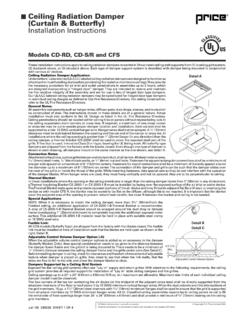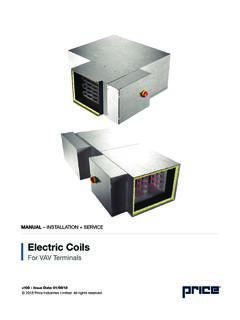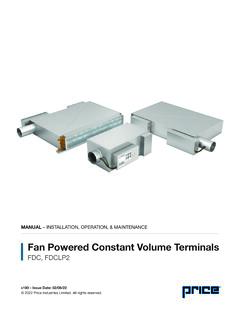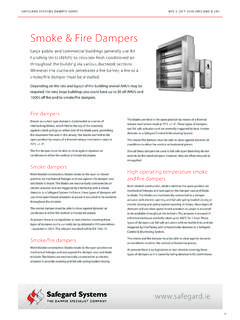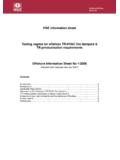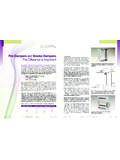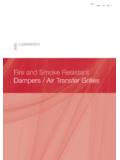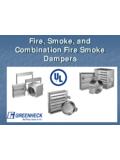Transcription of Fire/Smoke Dampers - Price Industries
1 All Metric dimensions ( ) are soft conversion. Copyright Price Limited 2006. Imperial dimensions are converted to metric and rounded to the nearest millimetre. Important General Notes:When UL is referred to in this document, it represents UL/ULC. This installation instruction applies to Combination Fire/Smoke Dampers (3V, Airfoil, Parallel, Opposed, Single, and Multi-blade types) mounted in the plane of an UL approved fire partition. Combination fire / smoke Dampers are approved for use in Static or Dynamic Systems. The Dampers are designed for operation in the vertical or horizontal position with blades running horizontal. The Dampers are to be installed square and free from twisting or racking. The Dampers shall not be compressed or stretched into the and installation of the Dampers shall be handled with the sleeve or frame. Do not lift the damper with the blades or actuator.
2 Special care shall be given to the damper before installation and after to insure it is protected against dirt, weather, mortar and drywall dust, wall texture and paint. Any of these conditions could cause the damper not to operate correctly and void the warranty. Suitable access to inside duct is to be provided for inspection and replacement of parts such as heat response devices and actuators per NFPA 90A and local authority having jurisdiction. The need to seal the damper in the penetration is not required by Underwriters Laboratories. Price Dampers have been tested and approved to be mounted without the use of sealants around the perimeter space between the damper and the penetration. As with all joints, contractor must seal duct-collar connections in the field after installation. Price Model numbers which are UL approved to utilize this installation are FSD-3V-211, FSD-3V-212, FSD-3V-231, FSD-3V-232, FSD-AF-211, FSD-AF-212, FSD-AF-231, Opening Preparation/Clearances:The fire barrier opening shall be larger than the damper to allow for thermal expansion and ease of installation.
3 When steel stud/ Fire/Smoke DampersInstallation Instructionsgypsum or wood stud/gypsum partitions are being used then refer to Fig. 1-3 for additional information and Damper Assemblies Using 2 Angles Methods (see note 4a) shall be a minimum of 1/8"(3mm) per linear foot (305mm) of height and width of sleeved assembly up to a maximum of 1 1/2 (38mm) and a minimum of 1/4 (6mm). The maximum single section multi-blade damper is 36"x48" (914mmx1219mm) in vertical or horizontal mountings. This method is acceptable for 1 1/2 and 3 hour fire Dampers . See Underwriter s Laboratories Listings for maximum multiple assembly Damper Assemblies Using 1 Angle Methods (see note 4b) shall be a minimum of 1/8"(3mm) per linear foot (305mm) of height and width of sleeved assembly up to a maximum of 1 1/2 (38mm) and a minimum of 1/4 (6mm). The maximum single section is the same as in A above.
4 The maximum multi-section is 108"w and 108"h (2743mm x 2743mm) up to 36 square feet ( sq. meters). This method is acceptable for 1 1/2 hour fire Dampers mounted in a masonry/concrete or steel stud/ gypsum wall Damper Assemblies Using No Angles Methods (see note 4c) shall be a minimum of 1/4"(6mm) and a maximum of 1/2 (13mm). The maximum single section is the same as in A above. The maximum multi-section is 42"w x 48"h (1067mm x 1219mm). This method is acceptable for 11/2 hour fire Dampers mounted in a masonry/concrete or steel stud/gypsum wall Damper Sleeves and Breakaway Connections:Sleeves shall be of the SAME GAUGE or heavier as the duct to which it is attached, if one of the breakaway connections is used as defined in the SMACNA fire , smoke and Radiation Damper Guide for HVAC Systems (Fig. 4-6) and in NFPA 90A. Gauges shall conform to SMACNA or ASHRAE duct standards.
5 Sleeves shall not extend beyond the fire barrier more than 6"(152mm) unless an actuator or factory installed access door is supplied, then the sleeve may extend up to 16"(406mm). Sleeve shall terminate at both sides of wall within dimensions shown. If a rigid connection is used, then the sleeve shall be a minimum of 16 gage for Dampers up to 36"(914mm) wide by 24"(610mm) high and 14 gage for Dampers exceeding 36"(914mm) wide by 24"(610mm) and oval breakaway connections must use either a 4"(102mm) wide draw band or #10 (M5) sheet metal screws spaced equally around the circumference of the duct as follows: 3 screws for duct sizes 22"(559mm) and smaller; 5 screws for duct sizes greater than 22"(559mm) and up to and including 36"(914mm): 8 screws for duct sizes greater than 36"(914mm). Refer to SMACNA fire , smoke and Radiation Damper Guide for HVAC Systems for information on Ductmate, Nexus, Ward, TDC and TDF systems and any additional information (Fig.)
6 5-6). A sleeve may not be required if the damper frame is of sufficient size and shape so the mounting angles can be directly fastened to Multi-Section and Damper to Sleeve Connections:Damper shall be secured to the sleeve and to each other (when joined to make multiple damper assemblies) with #10 sheet metal screws, 1/4 (6mm) nut and bolts, 1/4 (6mm) tack welds, 3/16 (5mm) steel rivets, spot welds, or clinching(toggle) on 6" (152mm) field assembling multi-sections, a continuous 1/8 (3mm) bead of Dow Corning 999, Dow Corning Silastic 732, Nuflex 302, or GE RTV 108 Sealant shall be applied to the frame joints and where the frame connects to the sleeve. Sealant is required only on one side of the damper. Press the surface of the sealant in place to dispel any / 06 245069 SHEET 1 OF 4 All Metric dimensions ( ) are soft conversion. Copyright Price Limited 2006.
7 Imperial dimensions are converted to metric and rounded to the nearest millimetre. 4. Methods of Securing Damper in Opening:a. Two Angle (Two Sided) Method: This method is the oldest and most commonly used. This method is approved for use in UL approved concrete/masonry partitions, steel stud/gypsum walls, and wood stud/gypsum walls. In this method 2 sets of angles are used to secure the damper in the opening, one on each side of the partition (See Fig. 7). Two Angle Method is approved for 11/2 and 3 hour Dampers , vertical or horizontal orientation, and any maximum size multi-section UL approved damper (see Underwriter s Laboratories Listings for maximum assembly sizes). Angles shall be a minimum of 11/2 x 11/2 (38mm x 38mm) x 16 gauge. Angles are to be fastened to the sleeve on 6" (152mm) centers with #10 (M5) sheet metal screws, 3/16" (5mm) steel pop rivets, 1/2 (13mm) tack welds, or 1/4 (6mm) diameter nut and bolts with not more than 2" (51mm) from each end with a minimum of two connections per side/leg.
8 The angles are to overlap the partition a minimum of 1" (25mm). These angles may be of a unit type construction and may or may not be fastened to each other at the corners. When the duct work terminates at the damper or installation prohibits angles from turning out/away from the wall, the retaining angle shall be reversed (leg turned into the opening) providing the size of the opening is increased by an amount equal to twice the combined thickness of the angle and the height of the screw or bolthead to maintain expansion clearances. See note 1A for information on clearances. See Fig. 7 for detailed drawings of One Angle (Single Sided) Method: In this method 1 set of angles are used to secure the damper in the opening. This method is approved for use in UL approved concrete/masonry partitions and steel stud/gypsum walls. Only one side of the fire partition will have the angles installed (see Fig.)
9 8). One Angle Method is approved for 11/2 hour Dampers only, vertical and horizontal (angles on top side only) orientations, and the maximum size shall be 108 wide or 108 high (2743mm x 2743mm) up to 36 square feet and up to the maximum multi-sectionUL approved damper size (see Underwriter s Laboratories Listings for maximum assembly sizes). Angle shall be a minimum of 11/2 x 11/2 (38mm x 38mm) by 16 gauge. Angles are to be fastened to the sleeve on 6 (152mm) centers with #10 (M5) sheet metal screws, 3/16 (5mm) steel pop rivets, 1/2 (13mm) tack welds, or 1/4 (6mm) diameter nut and bolts with not more than 2 (51mm) from each end with a minimum of two connections on each side/leg top and bottom. The angles are also to be fastened to the fire partition with: in concrete/masonry partitions with #10 (M5) self-tapping concrete anchors or concrete screws on 6 (152mm) centers and must engage the fire partition a minimum of 11/2 (38mm); in steel stud/gypsum partitions secure the angles to the partition with #10 (M5) screws long enough to penetrate the J-Runners and E-Stud by a minimum of 3/8 (10mm).
10 Use a minimum of two fasteners per side. The angles are to overlap the partition a minimum of 1 (25mm). These angles may be of a unit type construction and may or may not be fastened to each other at the corners. When the duct work terminates at the damper or installation prohibits angles from turning out/away from the wall, the retaining angle shall be reversed (leg turned into the opening) providing the size of the opening is increased by an amount equal to twice the combined thickness of the angle and the height of the screw or bolt head to maintain expansion clearances. Angles can be placed in front of or behind the drywall attaching directly to the steel studs or masonry. Price s Frame Retaining Angles (FRA) can be used in place of the angle mentioned above. See note 1B for information on clearances. See Fig. 8 for detailed drawings of No Angle Method: In this method No angles are used to secure the damper in the opening.






